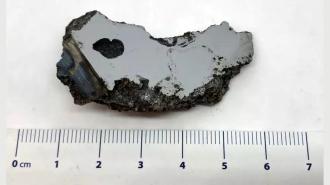Canadian scientists have identified two new minerals never seen before in nature — and they came to our planet inside a 4.5-billion-year-old meteorite.
New minerals: Minerals are solid elements or compounds with orderly internal structures, and they come in many forms — to date, we’ve discovered more than 5,000 minerals on Earth, including calcite, diamond, and quartz, and even a handful of unique minerals on the moon.
Now, scientists at the University of Alberta have identified two new minerals while analyzing a sample of “El Ali,” a massive 16.5-ton meteorite in Somalia. The space rock was discovered by scientists in 2020, but known to locals — who call it “Nightfall” — for generations.
The researchers have already spotted signs of a third new mineral in their sample.
The researchers have named the new minerals “elaliite” and “elkinstantonite,” after the meteorite itself and Lindy Elkins-Tanton, vice president of the Arizona State University Interplanetary Initiative, respectively.
“Lindy has done a lot of work on how the cores of planets form, how these iron nickel cores form, and the closest analogue we have are iron meteorites,” said U of A geologist Chris Herd, “so it made sense to name a mineral after her and recognize her contributions to science.”
The discovery: Herd was analyzing a 70-gram slice of El Ali in an attempt to classify the meteorite (spoiler: it’s an “iron, IAB complex” meteorite) when he saw signs of entirely new minerals.
He brought the sample to Andrew Locock, head of the U of A’s Electron Microprobe Laboratory, who was able to match the composition of the new minerals to ones that had been created synthetically before but never discovered in nature.
The researchers have already spotted signs of a third new mineral in their sample and believe that they might discover even more if more of the huge meteorite is analyzed.
“It means that the actual geological conditions, the chemistry of the rock, was different than what’s been found before.”
Chris Herd
Why it matters: Minerals form through geological processes — calcite forms when water rich in calcium evaporates, heat and pressure below Earth’s surface can turn carbon atoms into diamonds, and as magma cools, it can crystalize to form quartz.
The discovery of new minerals, then, has bigger implications for our understanding of the universe’s geology.
“Whenever you find a new mineral, it means that the actual geological conditions, the chemistry of the rock, was different than what’s been found before,” said Herd. “That’s what makes this exciting: In this particular meteorite you have two officially described minerals that are new to science.”
“Material scientists are interested too because of the potential uses in a wide range of things in society.”
Chris Herd
Minerals have many practical uses, too — your smartphone likely contains at least 30 different minerals — so the discovery of elaliite and elkinstantonite could end up doing more for humanity than helping us rewrite geology books.
“Whenever there’s a new material that’s known, material scientists are interested too because of the potential uses in a wide range of things in society,” said Herd.
We’d love to hear from you! If you have a comment about this article or if you have a tip for a future Freethink story, please email us at tips@freethink.com.
